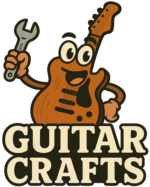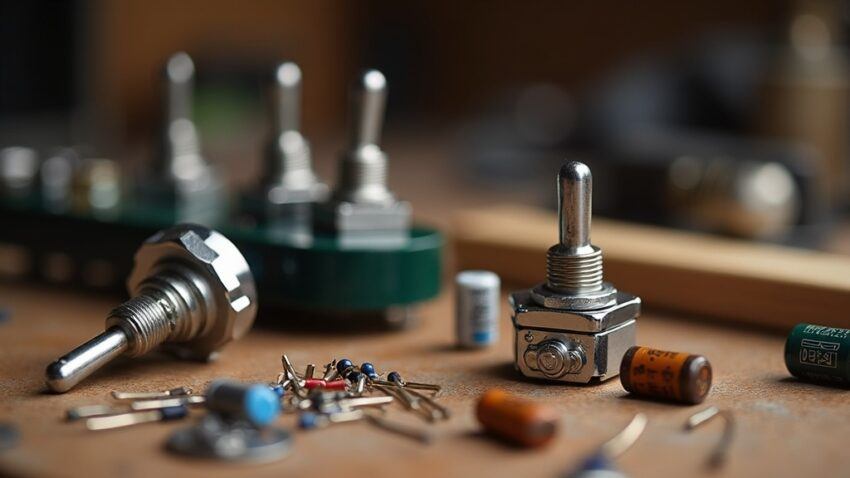If you’re trying to squeeze the most character and clarity from your electric guitar, picking the right capacitors and potentiometers (pots) for your wiring upgrade is a real gamechanger. That’s exactly what we’ll cover in Choosing Capacitors And Pots For Your Electric Guitar Wiring. Even if vintage tone isn’t your main goal, dialing in the best values and types for your needs can make your guitar respond quicker, sound smoother, or give you that detailed control you’ve been missing. The variety out there is huge, so let’s break things down to the details that truly matter.
What Do Pots and Capacitors Actually Do in Guitar Wiring?
Basically, pots are variable resistors. They adjust how much of your pickups’ signal is sent to ground. This impacts both volume and tone. Capacitors, meanwhile, shape which frequencies the tone pot sends to ground. Change that value, and you start to hear differences in treble roll-off, clarity, and overall warmth.
The key is seeing which values do what and matching them up to your guitar’s pickups and your personal style. Even small swaps can mean big changes, and these parts are some of the best low-cost mods you can try.
** Here’s a little transparency: Our website contains affiliate links. This means if you click and make a purchase, we may receive a small commission. Don’t worry, there’s no extra cost to you. It’s a simple way you can support our mission to bring you quality content.**
As an Amazon Associate, I earn from qualifying purchases.
A Quick Look at Potentiometer Types and Values
Most guitars use two major types of pot values: 250K (kilo-ohms) or 500K. This number shows the resistance the pot gives before grounding your signal. There are two main tapers: log (audio) and linear. Audio taper pots are generally preferred for both tone and volume, because their sweep feels gradual and natural as you turn them.
- 250K Pots: Ideal for single-coil pickups (like those on Stratocasters or Telecasters). They warm up your sound by chopping off a little extra treble.
- 500K Pots: Used mainly with humbuckers, as they keep more treble, giving the sound a brighter and more open quality. Great for darker-sounding pickups or heavier styles.
- 1M Pots: Some modern and super-bright guitars use these, or if you want maximum clarity from your pickups. They aren’t as common, but they do show up in certain designs.
Even with your knob maxed, pot value can affect overall brightness. So, if your guitar is too muddy or sharp, the pot type could be why.
Choosing a Capacitor for Your Guitar Tone Pot
The capacitor shapes your tone pot’s filter, rolling off high frequencies as you turn down the tone. Here’s the fast version:
- 0.022µF (microfarads): Usually paired with humbuckers. Lets those mids and highs shine, cutting gnarly treble as you dial the pot back.
- 0.047µF: Go-to cap for single-coils. Rolls off just a bit more high-end as you crank the knob down.
- 0.1µF: Produces a really mellow, warm tone—often found in vintage-style or bass setups.
If you crave brightness, stick to 0.022µF; if you want to mellow out harshness, check out 0.047µF or higher. Musicians love to try different combos, since caps are inexpensive and quick to swap out. Don’t worry if your first choice isn’t perfect — it’s a cheap tweak either way.
Matching Pots and Caps: What Works Best Together?
Pairing the right pot and cap values is important for dialing in great tone. Classic Strat and Tele setups thrive on 250K audio taper pots and 0.047µF caps, keeping things sparkly but never too shrill. Les Paul and similar humbucker guitars tend to use 500K audio taper pots and 0.022µF caps, so their pickups stay lively and open.
What you’ll often see:
- 250K pots + 0.047µF cap: Standard for Fender-style single-coil guitars.
- 500K pots + 0.022µF cap: Mainstay for Les Pauls and most humbucker setups.
If you try 250K pots with a 0.022µF cap, you may notice a touch more brightness than with 0.047, but the tone will still be a bit warmer than a 500K pot would give.
What Capacitor Should I Use In My Guitar?
This is a super popular question, and your answer hinges on your pickups and style. Blues and classic rock players using Fender-style guitars should usually start with a 0.047µF cap. For humbucker clarity, go for 0.022µF. Chasing old-school jazz or super thick tones? A bigger value like 0.1µF could be best. Your ears are the final judge, so try a couple and see what wins. Cap type — ceramic, polyester (the “orange drop” look), or vintage paper-in-oil—can make subtle changes. While some players chase fancy caps, for most, the value you pick matters more than material — unless you’re really after old-school authenticity.
How Do I Know What Potentiometer to Use On My Guitar?
The type of pickup in your guitar is the best clue. Single-coil setups nearly always feel great with 250K pots, providing a warm and balanced sound. Humbucker-equipped guitars sound brighter and more defined using 500K pots. If there’s extra darkness (mud) with everything turned up, try bumping up the pot value. If things are too bright or harsh, drop it lower. For most, tried-and-true setups are your safety net, but it’s fun to experiment.
Pot quality counts. Popular brands like CTS and Bourns are rock-solid. Push-pull pots can give you added wiring tricks like coil splits or phase switches without any new holes. Just make sure you match the shaft type (solid, split, knurled) to your existing knobs, or you might find they don’t fit right.
What Capacitor To Use With 250K Pots?
Most of the time, 250K pots are matched with 0.047µF caps. This blend smooths out single-coil treble while keeping a lively top end. Want it even warmer? Grab a 0.1µF cap. If your guitar is already really bright, a bigger value can help tame it even more. Don’t be afraid to experiment to zero in on your sweet spot.
What Are The Best Potentiometers For Guitars?
Brands to count on include:
- CTS: Original equipment for Fender and Gibson, they’re durable, smooth, and reliable. Available as either solid or split shafts.
- Bourns: Noted for a really smooth and fast-turning feel. Preferred by players who want less resistance while adjusting.
- Alpha: Lower cost, but still dependable. Great for budget upgrades or kit builds.
Stick with audio taper pots for both tone and volume in most cases, but if you want to experiment with bass or specialty wiring like blend pots, you might want to try linear taper. Matching the shaft type to your guitar’s existing knobs is a detail worth getting right, so your controls feel and look correct.
Extra Tips for Upgrading Your Pots and Capacitors
- Clean Your Ground Connections: Noise or scratchy pots often mean dirty or loose solder joints, not always old hardware.
- Try a Treble Bleed: If your volume pot cuts high end when you turn it down, a treble bleed (small cap with or without a resistor) across volume lugs can help keep brightness as you lower the volume.
- Shielding Tape Can Help: Adding copper tape isn’t required, but it can cut buzz or hum when you’re replacing or modding parts.
- Mix and Match: Some players like a 500K volume pot with a 250K tone pot. Break the rules—find combinations that your ears love.
Frequently Asked Questions
Question: Does cap value affect tone with the knob on “10”?
Answer: No, the cap is out of the circuit when your tone knob is all the way up. It only changes your sound as you roll the knob down.
Question: Are all caps the same no matter the type?
Answer: For most players, the capacitance value matters way more than type. Ceramic, polyester, or paper-in-oil may have subtle differences, but value is king for tone changes.
Question: What if my volume pot turns off suddenly instead of gradually lowering volume?
Answer: This probably happens because you have a linear pot instead of an audio taper pot for the volume. Switch to an audio taper for smoother control.
Wrapping It Up…
Swapping pots and capacitors is a wallet-friendly way to shape your guitar’s character and get more in touch with your playing style. A soldering iron and a few minutes can open up new sound-shaping choices. Play it safe by starting with classic pairings for your pickups, then branch out as you get more comfortable. Sometimes, a small wiring upgrade is all it takes to fall in love with your instrument again, and with a little trial and error, you can truly make your guitar feel brand new.
There are 100’s of ways you can build a business around your passion for guitar building.
Check it out…



This was such an informative breakdown of pots and capacitors. Thank you for explaining it so clearly! I don’t play the electric guitar myself, but my nephew does, and I’ll definitely be sharing this with him. The way you explained how different values pair with single-coils vs. humbuckers makes it much easier to follow, even for someone like me.
Quick question: Do you think these kinds of upgrades make the most difference for beginners learning to shape their tone, or are they more noticeable for experienced players who already know their sound?
Thank you so much for your kind words! I’m glad the breakdown was easy to follow, even if you’re not playing yourself — it’s always great when the info can be shared with someone learning, like your nephew.
As for your question: these upgrades can make a noticeable difference for both beginners and experienced players, but in slightly different ways. For beginners, changing pots and capacitors can open up new tonal possibilities and help them start understanding how tone shaping works, even if they’re still finding their own sound. For more experienced players, the difference is often more subtle and nuanced — they’ll notice the way certain values emphasize or smooth out frequencies, which can really refine their signature tone.
Either way, it’s a fun way to explore and experiment with sound.
Thanks again,
~Wayne